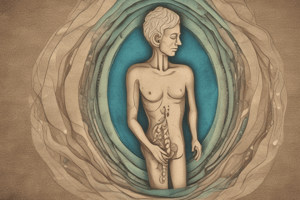Podcast
Questions and Answers
What is the primary cause of urge incontinence in patients?
What is the primary cause of urge incontinence in patients?
- Abnormal rectal compliance
- Weakness of the external anal sphincter (correct)
- Decreased rectal sensation
- Weakness of the internal anal sphincter
What is the primary role of the internal anal sphincter in fecal incontinence?
What is the primary role of the internal anal sphincter in fecal incontinence?
- Maintenance of rectal sensation
- Regulation of stool consistency
- Relaxation to allow contents into the upper anal canal
- Prevention of passive fecal incontinence (correct)
What is the significance of a patient's obstetric history in the evaluation of fecal incontinence?
What is the significance of a patient's obstetric history in the evaluation of fecal incontinence?
- It is irrelevant to the diagnosis
- It is used to determine the severity of incontinence
- It is used to rule out other gastrointestinal disorders
- It helps to identify the underlying cause of incontinence (correct)
What is the primary component of a physical examination in the evaluation of fecal incontinence?
What is the primary component of a physical examination in the evaluation of fecal incontinence?
What is the primary characteristic of true incontinence?
What is the primary characteristic of true incontinence?
What is a common underlying factor in patients with multifactorial fecal incontinence?
What is a common underlying factor in patients with multifactorial fecal incontinence?
What is the significant impact of fecal incontinence on an individual's life?
What is the significant impact of fecal incontinence on an individual's life?
What is the difference between fecal incontinence and anal incontinence?
What is the difference between fecal incontinence and anal incontinence?
What is urge incontinence?
What is urge incontinence?
What is the prevalence of fecal incontinence in the population over 70 years of age?
What is the prevalence of fecal incontinence in the population over 70 years of age?
What is a risk factor for fecal incontinence?
What is a risk factor for fecal incontinence?
Which part of the nervous system controls the internal sphincter muscle?
Which part of the nervous system controls the internal sphincter muscle?
What is the purpose of the rectoanal inhibitory reflex (RAIR)?
What is the purpose of the rectoanal inhibitory reflex (RAIR)?
What is the purpose of sensory discrimination training in biofeedback therapy?
What is the purpose of sensory discrimination training in biofeedback therapy?
What is the primary goal of biofeedback therapy for bowel control?
What is the primary goal of biofeedback therapy for bowel control?
What is the mechanism of manometric bio-feedback?
What is the mechanism of manometric bio-feedback?
What is the primary benefit of pelvic floor exercises, such as Kegel exercises?
What is the primary benefit of pelvic floor exercises, such as Kegel exercises?
What is a key factor in the success of biofeedback therapy for bowel control?
What is a key factor in the success of biofeedback therapy for bowel control?
What is the purpose of EMG bio-feedback in biofeedback therapy?
What is the purpose of EMG bio-feedback in biofeedback therapy?
What is the purpose of performing digital rectal examination in patients with fecal incontinence?
What is the purpose of performing digital rectal examination in patients with fecal incontinence?
What is the significance of anocutaneous reflex (anal wink sign) in patients with fecal incontinence?
What is the significance of anocutaneous reflex (anal wink sign) in patients with fecal incontinence?
What is the role of endorectal ultrasound/magnetic resonance imaging in the investigation of fecal incontinence?
What is the role of endorectal ultrasound/magnetic resonance imaging in the investigation of fecal incontinence?
What is the primary goal of patient selection in the management of fecal incontinence?
What is the primary goal of patient selection in the management of fecal incontinence?
What is the primary indication for surgery in the management of fecal incontinence?
What is the primary indication for surgery in the management of fecal incontinence?
What is the primary goal of biofeedback training in the management of fecal incontinence?
What is the primary goal of biofeedback training in the management of fecal incontinence?
What is the role of dietary modification in the management of fecal incontinence?
What is the role of dietary modification in the management of fecal incontinence?
What is a common cause of fecal incontinence in women?
What is a common cause of fecal incontinence in women?
What is the primary mechanism of action of injection therapy in treating fecal incontinence?
What is the primary mechanism of action of injection therapy in treating fecal incontinence?
What is the gold standard surgical procedure for treating fecal incontinence?
What is the gold standard surgical procedure for treating fecal incontinence?
What is the primary goal of conservative management in treating fecal incontinence?
What is the primary goal of conservative management in treating fecal incontinence?
What is the purpose of the screening phase in sacral nerve stimulation?
What is the purpose of the screening phase in sacral nerve stimulation?
What is the primary indication for using an artificial anal sphincter in treating fecal incontinence?
What is the primary indication for using an artificial anal sphincter in treating fecal incontinence?
What is the purpose of antegrade continence enema?
What is the purpose of antegrade continence enema?
What is the primary benefit of injection therapy compared to other surgical options?
What is the primary benefit of injection therapy compared to other surgical options?
What is the most common cause of fecal incontinence in adults?
What is the most common cause of fecal incontinence in adults?
Flashcards are hidden until you start studying
Study Notes
Importance of Fecal Incontinence
- Fecal incontinence has significant social and economic impacts
- It impairs quality of life and can contribute to the loss of ability to live independently
Terminology and Classification
- Fecal incontinence: involuntary loss of solid or liquid feces
- Anal incontinence: involuntary loss of solid or liquid feces or flatus
- Urge incontinence: desire to defecate, but incontinence occurs despite efforts to retain stool
- Passive incontinence: lack of awareness of the need to defecate before the incontinent episode
Epidemiology
- Fecal incontinence is commoner in females
- Underestimated and underreported due to patient factors
- More than 7% of the population over 70 years old is affected
Risk Factors
- Older age
- Diarrhea
- Faecal urgency
- Urinary incontinence
- Diabetes mellitus
- Hormone therapy
Anatomy and Physiology
- External sphincter: striated muscle (voluntary control)
- Internal sphincter: smooth muscle (involuntary control)
- Cerebral cortex: superior frontal and anterior cingulate gyri
- Enteric nervous system: regulates gut function
- Inferior mesenteric ganglion: sympathetic and parasympathetic innervation
- Pudendal nerve: S2-S4 spinal segments, innervates external anal sphincter
Anorectal Sampling and RectoAnal Inhibitory Reflex (RAIR)
- Every 8-10 minutes, internal sphincter relaxes, and rectal contents enter the upper anal canal
- RAIR: reflexive contraction of the internal sphincter in response to rectal distension
Aetiology and Pathogenesis
- Dysfunction of the anal sphincters
- Abnormal rectal compliance
- Decreased rectal sensation
- Incontinence is usually multifactorial
- Urge incontinence: weakness of the external anal sphincter, decreased rectal capacity, and rectal hypersensitivity
- Passive faecal incontinence: weakness of the internal anal sphincter
Evaluation
- History: determining the presence and severity of fecal incontinence
- Physical examination: inspection, digital rectal examination, and anocutaneous reflex testing
- Investigations: laboratory studies, endoscopy, anorectal manometry, endorectal ultrasound/magnetic resonance imaging, and defecography
Aetiology
- Mechanical: obstetric injury, fistula disease, trauma, iatrogenic, systemic disease
- Neurogenic: pudendal nerve stretch, strain, medical illness
- Idiopathic: no clear etiology
Principles of Management
- Patient selection is critical
- Medically manage those with minimal symptoms or poor surgical candidates
- Rehabilitation: physiotherapy, dietary modification, and medications
- Surgery reserved for those with repairable, neurologically intact sphincter
Treatment (Conservative)
- Dietary modification and medications
- Biofeedback
- Pelvic floor muscle training and electrostimulation
- Anal plug
Surgical Options
- Injection therapy
- Sphincteroplasty
- Sacral nerve stimulation
- Sphincter reconstruction-muscle transposition
- Artificial sphincters
- Magnetic anal sphincter
- Tibial nerve stimulation
- Stoma
Conclusion
- Majority of patients have a non-surgical cause
- Conservative management can improve symptoms in many patients
- Patient selection for surgery is critical
Studying That Suits You
Use AI to generate personalized quizzes and flashcards to suit your learning preferences.





